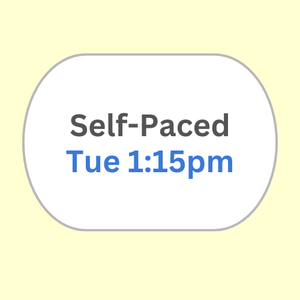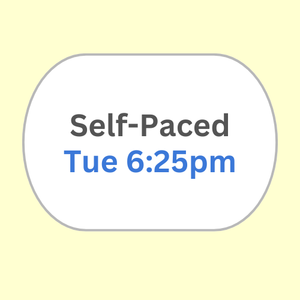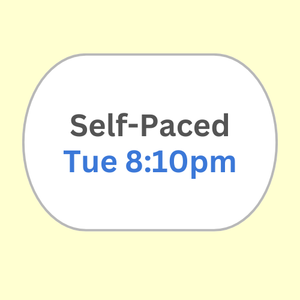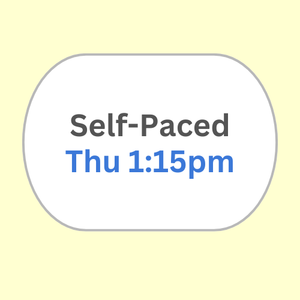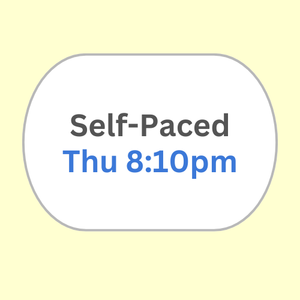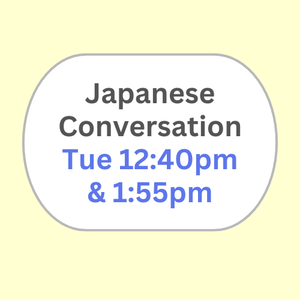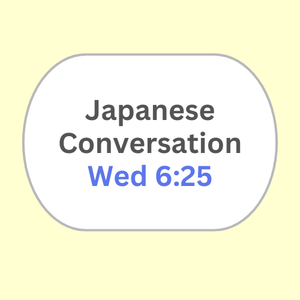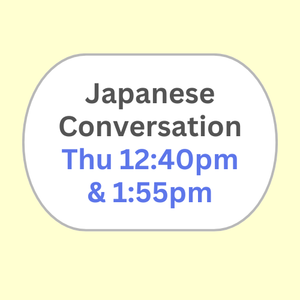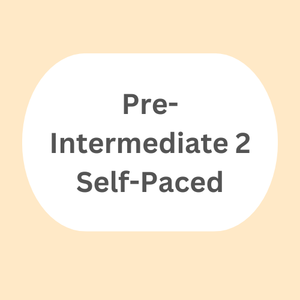Table of Contents
Who We Are
Beyond Language Learning
A Close-Knit Multilingual Community
Join us and become part of a vibrant community where Japanese and English learners teach and learn from each other.
Authentic and Immersive Practice
Experience genuine language practice with native Japanese speakers in our Japanese class providing endless opportunities for real-world application.
Supportive and Community-Centered
Embrace a relaxed, community-oriented approach to learning. Together, we support, grow, and share joyful moments, making every step of the journey enjoyable.
Follow us on Instagram!
Welcome to Pre-Intermediate Japanese 2, where your journey into the Japanese language continues to unfold!
This course builds on the skills developed in Pre-Intermediate Japanese 1, pushing you further into the grammar and vocabulary that characterize conversational fluency.
You’ll learn to navigate more complex scenarios, from discussing future plans to expressing preferences and opinions.
Our interactive lessons and practical activities are designed to strengthen your speaking, listening, reading, and writing abilities, while also deepening your cultural understanding.
Perfect for those looking to refine their Japanese, this class sets the stage for advanced learning.
After Taking This Course
After taking Pre-Intermediate Japanese 2 class at Blue House Okinawa,
you’ll be able to say Japanese phrases below:
*今日、すずきさんとびじゅつかんに行きました。
/ Today, I went to the art museum with Suzuki-san.
*待ち合わせの時間は2時半でした。
/ The meeting time was at 2:30.
*ちょっと道をまちがえました。
/ I got a little lost on the way.
*でも、2時20分ごろびじゅつかんにつきました。
/ But, I arrived at the art museum around 2:20.
*よかった!
/ That was good!
*すずきさんもいました。
/ Suzuki-san was also there.
*すずきさんはいつもはやいなあ。
/ Suzuki-san is always early.
*私たちは4時ごろまでいろいろなえを見ました。
/ We looked at various paintings until about 4 o’clock.
*とてもたのしかったです。
/ It was very enjoyable.
*こんばん、いそがしいですか。
/ Are you busy tonight?
*いいえ、ひまです。
/ No, I’m free.
*じゃあ、みんなで、タワーにやけいを見に行きませんか。
/ Then, how about we all go to the tower to see the night view?
*町がよく見えますよ。
/ You can see the town very well from there.
*いいですね。じゃあ、見に行きましょう。
/ Sounds good. Let’s go see it.
*それから、やけいのあとで飲みに行きませんか。
/ After seeing the night view, how about we go for drinks?
*安くて、いい店がありますよ。
/ There’s a cheap and good store.
*おさけですか。私はおいしいものを食べに行きたいです。
/ Alcohol? I want to go eat something delicious.
*おいしいものも、もちろんありますよ。
/ Of course, there will be delicious food too.
*いいですね。じゃあ、おねがいします。
/ Great, then please.
*私は大学のとき、ドイツ語を勉強しました。
/ I studied German when I was in university.
*ドイツ語は日本語とちがいます。
/ German is different from Japanese.
*ドイツ語ははつおんがすこしむずかしいです。
/ German pronunciation is a bit difficult.
*でも、ドイツ語は書くのがかんたんです。
/ But, writing in German is easy.
*私の町にはロシア人のかんこうきゃくがたくさん来ます。
/ Many Russian tourists come to my town.
*私はロシア語がすこしできますから、ときどきバスの乗りかたをおしえます。
/ Because I can speak a little Russian, I sometimes explain how to take the bus.
*私もいつかロシアに旅行に行きたいです。
/ I also want to travel to Russia someday.
*らいしゅうのピクニック、楽しみですね。
/ I’m looking forward to the picnic next week.
*3つれんらくします。
/ I will contact you three times.
*1. 食べ物はすずきさんと私が買っていきます。
/ Suzuki-san and I will buy the food.
*お金は一人 1,000円です。
/ It will be 1,000 yen per person.
*ピクニックのとき、私にください。
/ Please give it to me at the picnic.
*2. ケーキはチョコレートのケーキとバナナのケーキとどちらがいいですか。
/ Which do you prefer for the cake, chocolate or banana?
*へんじをお願いします。
/ Please reply.
*3. 飲み物はじぶんで持っていってください。
/ Please bring your own drinks.
*それから、コップやおさらもじぶんで持っていってください。
/ Also, please bring your own cups and plates.
*よろしくお願いします。じゃあ、またらいしゅう!
/ Thank you very much. See you next week!
*そのケーキ、どうですか。
/ How is that cake?
*あまりあまくなくて、とてもおいしいですよ。
/ It’s not too sweet and very delicious.
*中に何がはいっていますか。
/ What’s inside it?
*レモンがちょっとはいっています。
/ There’s a bit of lemon in it.
*そうですか。
/ Is that so?
*もう少しどうですか。
/ How about a little more?
*ありがとうございます。でも、もうおなかがいっぱいで…
/ Thank you, but I’m already full…
What We Will Learn
In Pre-Intermediate Japanese 2, we’ll study:
Lesson 7 – Lesson 12
*Nounでも いいですか
*Noun で、Verb て、
*もう Verb ました
*まだです
*Noun にいきます、Verb にいきます、Noun にきます、Verb にきます
*Noun のまえに
*Noun のあとで
*Noun 1 は Noun 2 が イ Adjective / ナ Adjective です
*Verb て ください ませんか
*Verb かた
*Verb たい です、Verb たくない です
*週に1回、月に1回、年に1回ぐらい
*Verb て みます
*Verb ましょうか
*Verb て いきます、Verb て きます
*なんでも、いつでも、どこでも、いくつでも
*Noun 1 と Noun 2 どちらがいいですか
*Noun 1 が いいです
*イ Adjective そうです、ナ Adjective そうです
*イ Adjective そうな Noun、ナ Adjective そうな Noun
*イ Adjective くて、イ Adjective くなくて、ナ Adjective で、ナ Adjective じゃなくて
Self-Paced Method
Personalized Mastery with Self-Paced Learning
The journey to mastering Japanese becomes even more personalized with a self-paced method, combining the best of flexibility with the invaluable support of a dedicated instructor at Blue House Okinawa. This approach adapts to your rhythm, creating a learning experience tailored to your individual needs.
Tailored Learning Pace
A self-paced method at Blue House Okinawa empowers you to control the speed of your learning, allowing you to spend more time on challenging concepts or breeze through familiar topics. You don’t have to wait for other students, enabling you to advance more quickly. This flexibility ensures that your study of Japanese aligns with your personal learning style and daily schedule, making language acquisition a seamless part of your life rather than a disruptive obligation.
Accelerate Your Learning Journey
A significant benefit of the self-paced method is the ability to advance quickly through your studies. You can move forward as soon as you’re ready, making your learning experience more efficient and rewarding. Many students find that they can progress faster with a self-paced approach. By focusing on familiar topics briefly and spending more time on challenging areas, you can tailor your study sessions to your strengths and weaknesses, keeping you motivated and engaged.
Direct Instructor Support When Needed
While the self-paced method offers autonomy, the role of an instructor remains pivotal. Whether you need clarification on complex grammatical structures, pronunciation practice, or insights into cultural nuances, your instructor is there to provide targeted support. This blend of independence and expert guidance ensures you’re never truly alone on your path to fluency.
Deepened Understanding Through Flexibility
The beauty of a self-paced approach lies in the liberty to pause and dive deeply into areas of interest or difficulty. Without the pressure to keep up with a preset class pace, you can ensure that your understanding of the Japanese language is deeply rooted. This flexibility encourages a more reflective and thorough engagement with the language, leading to lasting comprehension and proficiency.
The benefits of a self-paced method supported by an instructor in the context of learning Japanese are manifold. From the flexibility that caters to individual lifestyles to the tailored learning experiences that address specific needs, this approach offers a personalized pathway to language mastery. With the added advantage of deepened understanding and enhanced motivation, learners are well-equipped to embark on a rewarding journey toward fluency in Japanese. Embrace the opportunity to learn at your pace, guided by expertise, and discover the joys of language learning tailored just for you.
Our Textbook
Our textbook, “Marugoto,” is designed specifically for adult learners of Japanese.
It emphasizes not only the use of Japanese for communication but also the understanding and respect for different cultures.
The textbook prioritizes listening, speaking, and conversational skills, catering to those who wish to quickly acquire basic Japanese proficiency.
It includes various scenarios featuring interactions among people from diverse cultural backgrounds, all conducted in Japanese.
Students like the textbook for its realistic speaking scenarios and the audio resources available through its online platform.
Many appreciate the opportunity to enhance their practice independently through its interactive online components.
Additionally, “Marugoto” offers a glimpse into various facets of Japanese culture via photographs and illustrations, accompanied by numerous natural conversational examples.
The online learning center enables students to study anytime, anywhere, providing more opportunities to practice Japanese, especially during classroom sessions.

How to Study
1. Sign up for Minato
The Japan Foundation’s JF Japanese e-Learning Minato is a platform dedicated to the study of the Japanese language.
“Minato,” translating to “port,” symbolizes a gathering place for learning and connecting with others who share a similar interest.
At Minato, we offer an invitation to deepen your comprehension and insight into Japan, its people, and their language.
At Minato, a diverse array of Japanese courses awaits you online, making it easier than ever to start your journey into the Japanese language from wherever you are, at any time that suits you.
Have you ever felt discouraged from learning because classes were out of reach, or found yourself too busy to travel for lessons?
Or perhaps you’re curious about starting but feeling a bit apprehensive?
Minato is designed for you.
Here, you can personalize your learning experience by selecting the course level, type, study category, and language of instruction that best fits your needs.
Get ready to embark on your learning adventure with us.
2. Study Marugoto A2-1 on Minato
This course is designed to offer a thorough understanding of both the Japanese language and culture.
Within the Katsudoo section, participants are afforded the opportunity to develop practical communication skills applicable to daily scenarios.
This is achieved through extensive exposure to Japanese, enhancing your ability to speak by actively listening.
Conversely, the Rikai section is structured to provide a systematic approach to learning how Japanese functions in communicative contexts.
The ultimate goal is to cultivate a comprehensive proficiency in Japanese, encompassing reading, listening, writing, and speaking abilities.
3. Flashcards and Practice on Our Online Resources
You’re zipping through your day, and whether you’re on a coffee break or waiting in line, your phone becomes your gateway to a quick Japanese lesson.
With digital flashcards, you’re actively engaging with the language, thanks to the magic of spaced repetition.
It ensures you review words right when your brain is about to let them slip, making learning stick better.
And if you ever feel like you’re running out of cards, there’s a whole world of pre-made decks online, waiting to be explored.
Example Flashcards:
4. Flashcards “Learn” on Study Room
To use these flashcards, Select or type the correct answer.
Settings and options
To customize your session, open the Options menu.
You can choose to answer with terms, definitions, or a specific language (if applicable).
You can also choose to study only starred terms, change your audio settings, and select which question types are included.
5. Flashcards “Spell” on Study Room
Spell mode helps you practice spelling terms by prompting you to type what you hear.
To finish a round of Spell mode and see your results, you’ll need to spell each word correctly twice.
Settings and options
If you misspelled a word, the letters you missed will be highlighted and the word will be spelled out for you. Then, you can try it again.
You can slow down the audio by selecting Options and choosing Slow.
To hear a term again, click the Speaker.
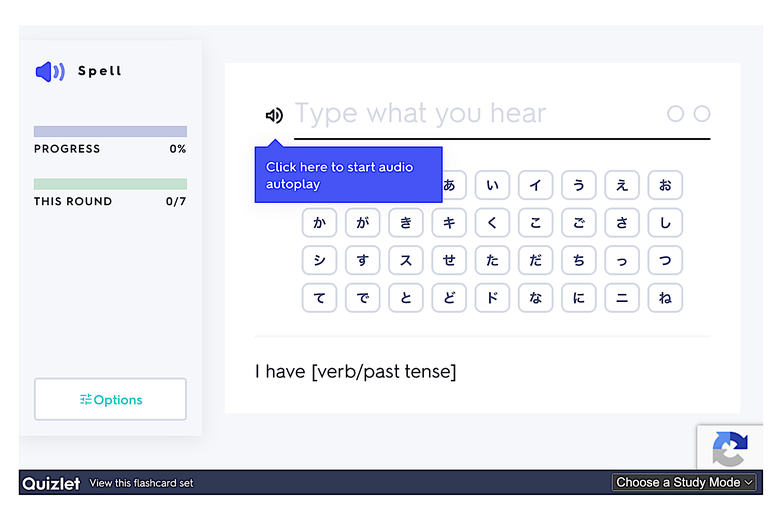
6. Lesson Quizzes on Our Online Resources
Get ready for a little victory at the end of each lesson, because that’s quiz time!
Aim for the stars and try to score 80% or higher on these quizzes.
The best part?
You can retake them as many times as you need to hit that sweet 80% mark or even go beyond.
Remember, repetition isn’t just a step in learning a new language—it’s the secret sauce!
So embrace those quizzes, and let’s see your scores soar!
7. Writing Practice on Workbook
After you’ve hit 80% or more on lesson quizzes, why not practice writing on workbook?
Practicing Japanese writing significantly enhances learning by improving memorization of kanji characters and their numerous compounds.
It facilitates a deeper understanding of sentence structure, grammar, and vocabulary, making the language more accessible.
Writing practice aids in mastering the nuances of kanji, hiragana, and katakana, crucial for reading and comprehension.
Additionally, it boosts confidence in using Japanese in real-world contexts, from casual conversations to formal writing.
Engaging with the writing system actively rather than passively listening or reading encourages active recall, reinforcing learning and retention.
Overall, writing practice is an indispensable tool in achieving fluency in Japanese.
8. 1 Post & 5 Comments on Our School Social Media
You asked for more ways to practice Japanese, and guess what?
We’ve got you covered with our school social media, made for you amazing students! 🌟
Now you can flex your language muscles anytime, anywhere—whether you’re chilling at home, on your daily commute, or just scrolling through your phone with some time to spare.
Dive into our school social media and you’ll find all sorts of fun ways to keep up with your Japanese studies.
Post, comment, slide into DMs, and do everything you need to boost your language skills.
Plus, you get to support our awesome local Japanese friends who are learning English, just like in our Language Exchange program at school.
Feeling a bit shy about your Japanese?
Pop into the Living Room to ask if your Japanese hits the mark, or lend a hand (and your English skills) to help local students master English with your comments and posts.
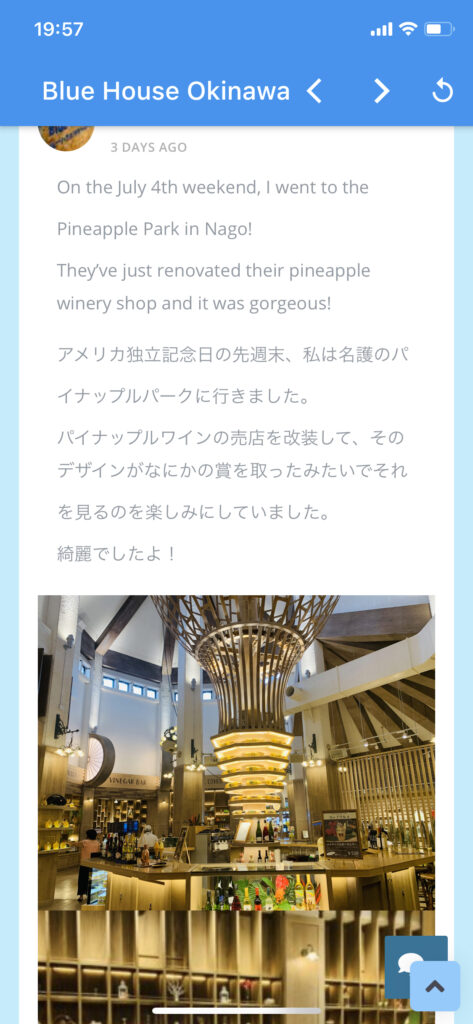
9. Host a Study Exchange
Want to try out your Japanese?
Or, do you like to practice your listening and speaking?
Then, host a Study Exchange and study with local Japanese friends!
At the Study Exchange, you can:
*see if you remember what you’ve learned.
*see if your Japanese friends understand your Japanese.
*listen to native Japanese speakers’ Japanese pronunciation.
*learn how native Japanese speakers use Japanese.
*understand what your Japanese friends think, how they look at things, and how they express their feelings.
*understand Japanese culture on a deeper level.
Sounds so exciting, right?
Oh after the Study Exchange, don’t forget to post the report for your review!

Practice in Class
1. Ask Questions if There Are Any
Asking questions in class is your secret weapon for learning!
It clears up confusion, deepens your understanding, and even helps your classmates who might be wondering the same thing.
Plus, it shows you’re engaged and eager to learn.
So don’t hesitate—every question is a step toward mastering the material!
2. Take the Performance Test with the Instructor
Taking the Japanese speaking performance test with your instructor is a golden opportunity in your language learning journey.
It’s not just a test; it’s a chance to get personalized feedback on your pronunciation, grammar, and conversational skills.
This experience boosts your confidence and hones your ability to speak Japanese fluently. Embrace this moment—it’s designed to highlight your strengths and guide your progress toward becoming a confident and proficient speaker.
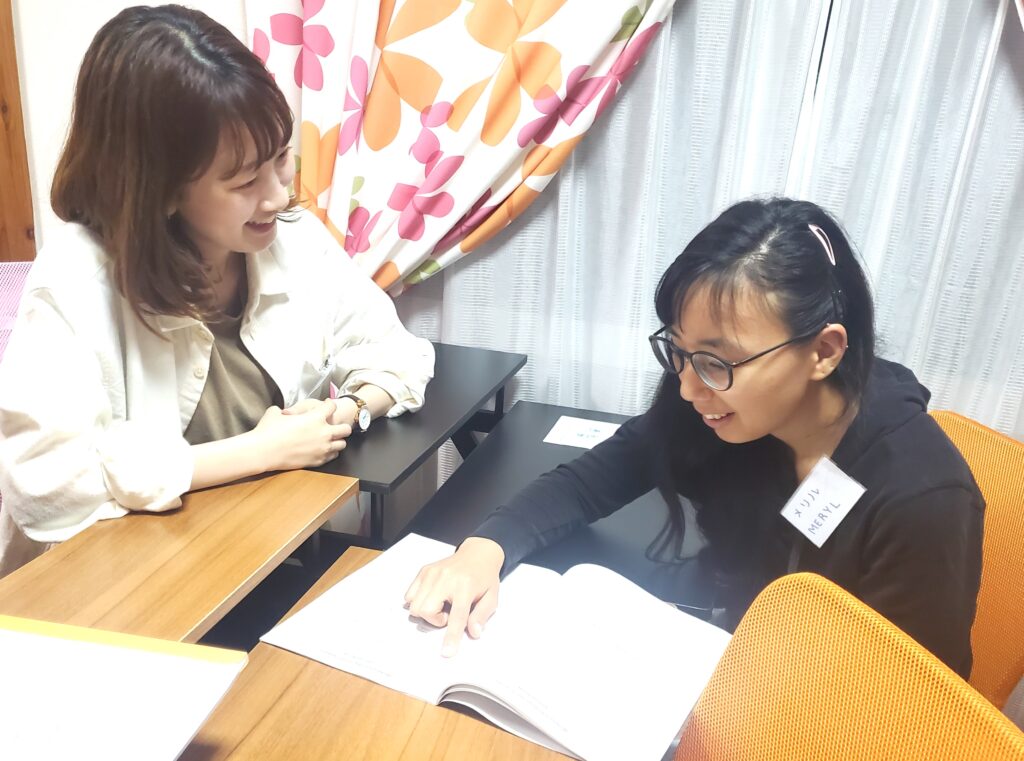
3. Listening and Speaking Practice with Native Japanese Speakers in Language Exchange
It immerses you in the language’s natural rhythm, intonation, and cultural nuances, making learning authentic and engaging.
This direct interaction boosts your listening comprehension and speaking fluency, allowing you to pick up colloquial expressions and slang.
Moreover, it builds confidence in real-world communication and fosters a deeper understanding of Japanese culture.
These exchanges are a crucial part of mastering the language in a way textbooks alone cannot provide.
4. Ask Native Japanese Speakers the Questions You Made
This immersive experience helps learners grasp nuanced pronunciations, understand colloquial expressions, and become familiar with cultural contexts, improving listening and speaking skills.
It encourages active learning through real-time feedback, helping to correct mistakes and clarify doubts immediately.
Engaging with natives also boosts confidence in using the language in everyday scenarios, making the learning process more enjoyable and effective.
Overall, it’s a direct, practical approach to mastering Japanese, making it easier to think and communicate fluently in the language.

Our Payment Methods
At Blue House Okinawa, we provide two tailored payment options to suit various needs and learning styles across different class settings. Whether you prefer an intensive learning environment or require flexibility to accommodate a busy schedule, we have the ideal class for you. Below, we outline the key differences between our Flexible Class and Regular Class.
Flex Class (Flexible Schedule)
In the Flex Class, you can purchase as many coupons as you’d like, then book and attend lessons at your convenience.
You can:
- Purchase the desired number of coupons each month and use them to book ANY LESSONS YOU LIKE.
- Coupons are valid only for the current 4-week subscription period and cannot be carried over to the next 4-week subscription period.
- Book lessons online, anytime and from anywhere.
- Easily reschedule your lessons if needed.
- Start learning now!
Regular Class
In the Regular Class, your class, schedule, and tuition are fixed. This helps you build a consistent Japanese study habit.
You can:
- Develop a steady and consistent study routine.
- Attend 8 lessons per month at a lower cost compared to the Flex 8 plan.
- Follow a fixed class schedule, attending the same class at the same time each week.
- Pay a fixed tuition fee, it covers one month/term regardless of your attendance.
- Rescheduling or make-up lessons for missed classes are NOT AVAILABLE.
- Begin the class at the start of each month.
For more details, please see the information below.
Flexible Schedule Class
Discover the Ultimate Flexible Schedule Class
In today’s fast-paced world, balancing work, studies, and family commitments can be challenging. Our Flexible Schedule Class is designed for busy individuals, those traveling from afar, and anyone who prefers online learning. This hybrid class offers the best of both worlds, allowing you to tailor your education to fit your lifestyle seamlessly. You can purchase coupons and book your lessons at your convenience, making it perfect for those with busy schedules.
Why Choose Our Flexible Schedule Class?
1. Pay Only for the Lessons You Attend
Like to attend Japanese classes but can’t commit to a weekly schedule? Then our Flex Class system is perfect for you. Simply purchase coupons and book lessons as they fit your schedule. You only pay for the lessons you actually attend, ensuring there’s no wasted money!
2. Create Your Own Lesson Schedule
With the Flex Class system, you have complete control over your schedule. Whether you want to focus intensively on studying Japanese by attending multiple classes each week or prefer a lighter schedule, you can customize your learning to match your availability. This flexibility allows you to balance personal and professional commitments while continuing your studies.
3. Buy as Many Coupons as You Need
You can purchase as many coupons as you like, depending on your goals and availability. If you’d like to dedicate more time to your Japanese studies, buy more coupons. If you have a busy month, you can buy fewer. It’s entirely up to you!
4. Easy to Continue
The flexibility of our Flex Class system makes it easier to continue your learning journey without interruptions. As your schedule changes, you can adjust your lessons accordingly, ensuring consistent progress. This adaptability is ideal for those with unpredictable commitments.
5. Coupons Can Be Used for Any Class
Your Flex Class coupons can be used for any class, whether it’s a self-paced beginners Japanese class or a Japanese conversation class. For example, with 8 lessons, you can attend 4 beginner classes and 4 conversation classes—or mix and match however you like!
6. Book Lessons Anytime, Anywhere
With our easy online booking system, you can book your lessons from anywhere at any time. You can book lessons as early as 1 hour before or up to 4 weeks in advance, making it convenient for even the busiest of schedules.
7. Easily Reschedule Lessons
If you need to cancel a lesson, you can do so up to 24 hours in advance, and your coupon will be available for another booking. This flexibility ensures that even with an irregular schedule, you can continue learning without stress.
8. Start now!
No need to wait for the start of a new term. With our Flex Class, you can begin your lessons and start using our online program and resources as soon as you sign up. Whether you’re eager to start immediately or prefer to plan ahead, our system lets you jump into learning right away.
9. Switch to Regular Classes Anytime
If your schedule changes and you have more time to dedicate to your studies, switching from our Flex Class to our Regular Classes is easy and can be done online. You can also adjust your class level or add another class after completing your current one. Our system is designed to grow with you!
Flexible Schedule Class Tuition
Registration Fee 11,000 yen
Class Materials
Japanese Conversation: 7,200 yen
Beginners Japanese 1 & 2: 7,700 yen
Beginners Japanese 3 & 4: 7,700 yen
Pre-Intermediate Japanese 1: 6,600 yen
Pre-Intermediate Japanese 2: 6,600 yen
Pre-Intermediate Japanese 3: 6,600 yen
JLPT Prep N5: 6,600 yen
JLPT Prep N4: 8,800 yen
JLPT Prep N3: 11,000 yen
*The registration fee and the class materials are required for a new student and each student.
Tuition Subscription Renewal Date
The subscription renewals monthly on the date you signed up. You can cancel the subscription at any time as needed.
Lesson Booking Policy
-You can book a lesson from 1 hour to 5 weeks before the lesson in advance.
-Your coupon will be available for use from the day your subscription renews for up to 4 weeks.
-Please note that the coupon cannot be carried over to the next 4-week subscription period.
-Coupons are displayed on the payment page and can be used by selecting them.
Lesson Cancellation Policy
-Cancellations made more than 24 hours before the scheduled lesson:
Your coupon will be reactivated and can be used to book another lesson.
Cancellations made within 24 hours before the scheduled lesson:
Your coupon will be forfeited and cannot be used for future bookings.
Please send your instructor a message on Living Room and let him/her know when you cancel a lesson within 24 hours before the scheduled lesson.
Class Cancellation Policy
-You may cancel your class, provided the coupon hasn’t been used.
-Cancellations made within 5 days of payment: 90% refund.
-Cancellations made more than 5 days after payment: No refund.
Upon cancellation of your subscription, access to lesson booking coupons, and online materials will be discontinued.
Flexible Schedule Class Tuition
– Self-Paced Class is for Beginners Japanese 1 – 4, Pre-Intermediate Japanese 1 – 3 and JPLT Prep.
– You can purchase coupons as many as you like and book your lessons at your convenience. Choose from the following options.
- Flex 1 ¥ 6,100
6,100 Yen/Lesson - 1 lesson a month.
- Flex 2 ¥ 11,000
5,500 Yen/Lesson - 2 lessons a month.
- Flex 3 ¥ 14,800
4,933 Yen/Lesson - 3 lessons a month.
- Flex 4 ¥ 18,500
4,625 Yen/Lesson - 4 lessons a month.
- Flex 6 ¥ 26,400
4,400 Yen/Lesson - 6 lessons a month.
- Flex 8 ¥ 33,400
4,175 Yen/Lesson - 8 lessons a month.
- Flex 10 ¥ 39,600
3,960 Yen/Lesson - 10 lessons a month.
- Flex 12 ¥ 46,200
3,850Yen/Lesson - 12 lessons a month.
- Flex 16 ¥ 59,800
3,738 Yen/Lesson - 16 lessons a month.
Register today to save your spot!
*Display price is a price for per lesson.
How to Book a Lesson
Once you sign up for the Flex class, you can start booking your lessons as below.
Your coupon will be applied on the checkout page.
Lesson Booking Policy
– You can book a lesson from 1 hour to 5 weeks before the lesson in advance.
– Your coupon will be available for use from the day your subscription renews for up to 4 weeks.
– Please note that the coupon cannot be carried over to the next 4-week subscription period.
– Coupons are displayed on the payment page and can be used by selecting them.
Check lesson availabilities below.
How to Cancel the Lesson
After booking a lesson, you can cancel it here if needed here.
*You need to be a student to access your account page.
*Lesson Booking Cancellation Policy
– Cancellations made more than 24 hours before the scheduled lesson:
Your coupon will be reactivated and can be used to book another lesson.
– Cancellations made within 24 hours before the scheduled lesson:
Your coupon will be forfeited and cannot be used for future bookings.
– Please send your instructor a message on Living Room and let him/her know when you cancel a lesson within 24 hours before the scheduled lesson.
Regular Class
At Blue House Okinawa, we provide two tailored payment options to suit various needs and learning styles across different class settings. Whether you prefer an intensive learning environment or require flexibility to accommodate a busy schedule, we have the ideal class for you. Below, we outline the key differences between our Regular Class and Flexible Schedule Class.
Intensive Learning with a Fixed Schedule
Our Regular Class is perfect for those committed to mastering Japanese. Attend classes weekly on the same days and times, ensuring a consistent and reliable routine. Benefit from regular, focused practice, immediate feedback from experienced instructors, and interaction with dedicated peers. This structured approach helps you stay disciplined, making steady progress towards fluency.
Why Choose Our Regular Class?
1. Easy to Build Study Habits
With a fixed schedule, it’s easier to build and maintain your study habits. Attending classes on the same days and at the same times each week helps integrate learning into your routine, making it a regular part of your life.
2. Accelerate Your Progress
Join our Regular class and attend lessons weekly to fast-track your language learning journey. Regular attendance not only enhances your understanding of the Japanese language but also speeds up your progress, helping you achieve your goals faster and more effectively.
3. Improve Listening and Speaking Skills Faster
Frequent classes enhance your Japanese listening and speaking skills more quickly too. Engaging in regular conversations with native Japanese speakers and receiving direct feedback from instructors improve your practical communication abilities.
4. Cost-Effective
The Self-Paced Regular Class is more cost-effective compared to taking eight/four Flexible Schedule lessons. This makes it an economical choice for those looking to maximize their learning within a budget.
5. Switch to Flex Class Anytime!
When you sign up for a Regular Class, you have the freedom to switch to a Flex Class anytime in the future. Changing your class is easy and can be done online with just a few clicks. Enjoy the flexibility to choose the learning style that best suits your needs!
Regular Class Tuition
Registration Fee 11,000 yen
Class Materials
Japanese Conversation: 7,200 yen
Beginners Japanese 1 & 2: 7,700 yen
Beginners Japanese 3 & 4: 7,700 yen
Pre-Intermediate Japanese 1: 6,600 yen
Pre-Intermediate Japanese 2: 6,600 yen
Pre-Intermediate Japanese 3: 6,600 yen
JLPT Prep N5: 6,600 yen
JLPT Prep N4: 8,800 yen
JLPT Prep N3: 11,000 yen
*The registration fee and the class materials are required for a new student and each student.
Regular Class
–Follow a fixed class schedule, attending the same class at the same time each week.
-Pay a fixed tuition fee, it covers one month/term regardless of your attendance.
-Rescheduling or make-up lessons for missed classes are NOT available.
-Begin the class at the start of each month.
Tuition
– Early Bird Discount
The payment for the upcoming term or month by the 20th of the preceding month are eligible for a 20% early bird discount.
– 2 Payment Methods
There are two payment methods available.
By Term: Covering a 2-month period.
By Month: Covering a 1-month period.
– Tuition Subscription Renewal Date
The subscription renews on the 20th of the preceding month. You can cancel the subscription at any time as needed.
Class Cancellation Policy
-90% refund for cancellation greater than 7 days prior to the 1st day of class
-50% refund for cancellation 1-7 days prior to 1st day of class
-NO refunds for cancellation after the 1st day of class
Register at least 1 day prior to the 1st day of class. If a class is already in session, please wait until the next term starts to register.
2025 School Calendar
Winter
Winter Break : 20 Dec ‘24 – 6 Jan ‘25
January : 7 Jan – 30 Jan
February : 4 Feb – 27 Feb
March : 4 Mar – 27 Mar
Spring
Spring Break : 28 Mar – 7 Apr
April : 8 Apr – 1 May
May : 6 May – 29 May
June : 3 Jun – 26 Jun
Summer
Summer Break : 27 Jun – 7 Jul
July : 8 July – 31 July
August : 5 Aug – 28 Aug
September : 2 Sep – 25 Sep
Fall
Fall Break : 26 Sep – 6 Oct
October : 7 Oct – 30 Oct
November : 4 Nov – 27 Nov
December : 2 Dec – 25 Dec
Winter Break : 26 Dec ‘25 – 5 Jan ‘26
Self-Paced Regular Class Tuition
– Self-Paced Class is for Beginners Japanese 1 – 4, Pre-Intermediate Japanese 1 – 3 and JPLT Prep.
– This class meets twice a week.
- By Term with Early Bird Discount ¥ 55,400
The payment for the upcoming term by the 20th of the preceding month.
- By Term with Regular Price ¥ 66,500
The payment for the upcoming term after the 20th of the preceding month.
- By Month with Early Bird Discount ¥ 27,700
The payment for the upcoming month by the 20th of the preceding month.
- By Month with Regular Price ¥ 33,900
The payment for the upcoming month after the 20th of the preceding month.
Japanese Conversation Class Tuition
– This class meet once a week.
– Tuition Subscription Renewal Date
The subscription renews on the 20th of the preceding month. You can cancel the subscription at any time as needed.
- By Term with Early Bird Discount ¥ 27,700
The payment for the upcoming term by the 20th of the preceding month.
- By Term with Regular Price ¥ 33,900
The payment for the upcoming term after the 20th of the preceding month.
- By Month with Early Bird Discount ¥ 15,400
The payment for the upcoming month by the 20th of the preceding month.
- By Month with Regular Price ¥ 18,500
The payment for the upcoming month after the 20th of the preceding month.
Register today to save your spot!
- Sale!

Pre-Intermediate Japanese 2
¥27,700 – ¥66,500Select options This product has multiple variants. The options may be chosen on the product page
Both the Regular Class and the Flexible Schedule Class offer unique benefits tailored to different needs. The Regular Class provides a structured environment that helps build consistent study habits, ensures faster progress, and improves practical language skills. On the other hand, the Flexible Schedule Class offers convenience and flexibility, allowing you to learn at your own pace, pay only for the lessons you take, and start immediately.
No matter which class you choose, you will receive high-quality instruction and support from our experienced teachers. Our goal is to provide you with the tools and resources you need to succeed in learning Japanese, whether you prefer a regular schedule or require the flexibility to fit learning into a busy life.
Join Us Today!
Don’t let a busy schedule or distance stop you from learning Japanese. Choose the class that best fits your needs and start your journey with us. Our flexible and regular classes are designed to accommodate your lifestyle and help you achieve your language learning goals.
How to Start
Here are the easy steps to get you started with your Pre-Intermediate Japanese 2 class.
1. Please take a moment to review our cancellation policy on the registration page.
2. Go ahead and sign up for the class.
3. Complete the online orientation. Don’t worry, we’ll send you the link automatically once you’ve registered.
4. Familiarize yourself with our student agreement and house rules.
5. Register and set up your profile on our school social media.
6. Install and set up the Japanese keyboard on your devices.
7. Introduce yourself on our school social media to connect with your classmates.
8. Once you’ve completed all the steps, drop us a message on Living Room.
We’re excited to have you join us and can’t wait to see you in class!
As we draw our Pre-Intermediate Japanese 2 class to a close, you’ve made substantial progress in mastering more nuanced aspects of the Japanese language.
Your ability to discuss a wider range of topics with greater complexity reflects your growing proficiency.
This course has equipped you with advanced grammar and vocabulary, paving the way for engaging in more sophisticated conversations and understanding deeper cultural contexts.
Continue to practice and expose yourself to the language as much as possible to retain and further develop your skills.
Your dedication is the key to your success—keep moving forward with enthusiasm and confidence!
Who We Are
Beyond Language Learning
A Close-Knit Multilingual Community
Join us and become part of a vibrant community where Japanese and English learners teach and learn from each other.
Authentic and Immersive Practice
Experience genuine language practice with native Japanese speakers in our Japanese class providing endless opportunities for real-world application.
Supportive and Community-Centered
Embrace a relaxed, community-oriented approach to learning. Together, we support, grow, and share joyful moments, making every step of the journey enjoyable.
Follow us on Instagram!









